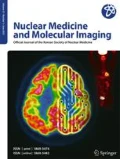Abstract
A 60-year-old man underwent vertical rectus abdominis myocutaneous flap to reconstruct a left lateral chest wall defect. For assessment of viability of muscle flap, F-18 fluoro-2-deoxyglucose (FDG) positron emission tomography/computed tomography (PET/CT) was performed 15 days after surgery. The FDG PET/CT showed a small metabolic defect in the left lateral chest wall. During follow-up, necrotic change of the graft was observed, and the site was in accordance with the area where the metabolic defect was observed in the FDG PET/CT. As a result, debridement and wound closure was performed. This case suggested that the FDG PET/CT should be a useful method for the monitoring of muscle viability after flap surgery.


References
Geis S, Schreml S, Lamby P, Obed A, Jung EM, Nerlich M, et al. Postoperative assessment of free skin flap viability by transcutaneous pO2 measurement using dynamic phosphorescence imaging. Clin Hemorheol Microcirc. 2009;43(1–2):11–8.
Kroll SS, Schusterman MA, Reece GP, Miller MJ, Evans GR, Robb GL, et al. Choice of flap and incidence of free flap success. Plast Reconstr Surg. 1996;98(3):459–63.
Repež A, Oroszy D, Arnež ZM. Continuous postoperative monitoring of cutaneous free flaps using near infrared spectroscopy. J Plast Reconstr Aesthet Surg. 2008;61(1):71–7.
Top H, Sarikaya A, Aygit AC, Benlier E, Kiyak M. Review of monitoring free muscle flap transfers in reconstructive surgery: role of 99mTc sestamibi scintigraphy. Nucl Med Commun. 2006;27(1):91–8.
Disa JJ, Cordeiro PG, Hidalgo DA. Efficacy of conventional monitoring techniques in free tissue transfer: an 11-year experience in 750 consecutive cases. Plast Reconstr Surg. 1999;104(1):97–101.
Smith GT, Wilson TS, Hunter K, Besozzi MC, Hubner KF, Reath DB, et al. Assessment of skeletal muscle viability by PET. J Nucl Med. 1995;36(8):1408–14.
Luu Q, Farwell DG. Advances in free flap monitoring: have we gone too far? Curr Opin Otolaryngol Head Neck Surg. 2009;17(4):267–9.
Schrey AR, Kinnunen IA, Grenman RA, Minn HR, Aitasalo KM. Monitoring microvascular free flaps with tissue oxygen measurement and PET. Eur Arch Otorhinolaryngol. 2008;265 Suppl 1:S105–13.
Sarikaya A, Aygit AC. Combined 99mTc MDP bone SPECT and 99mTc sestamibi muscle SPECT for assessment of bone regrowth and free muscle flap viability in an electrical burn of scalp. Burns. 2003;29(4):385–8.
Tukiainen E. Chest wall reconstruction after oncological resections. Scand J Surg. 2013;102(1):9–13.
Khalil HH, El-Ghoneimy A, Farid Y, Ebeid W, Afifi A, Elaffandi A, et al. Modified vertical rectus abdominis musculocutaneous flap for limb salvage procedures in proximal lower limb musculoskeletal sarcomas. Sarcoma. 2008;2008:781408.
Glatt BS, Disa JJ, Mehrara BJ, Pusic AL, Boland P, Cordeiro PG. Reconstruction of extensive partial or total sacrectomy defects with a transabdominal vertical rectus abdominis myocutaneous flap. Ann Plast Surg. 2006;56(5):526–30. discussion 30-1.
Siegel ME, Stewart CA, Wagner Jr FW, Sakimura I. An index to measure the healing potential of ischaemic ulcers using Thallium 201. Prosthetics Orthot Int. 1983;7(2):67–8.
Siegel ME, Stewart CA, Wagner W, Sakimura I. A new objective criterion for determining, noninvasively, the healing potential of an ischemic ulcer. J Nucl Med. 1981;22(2):187–9.
Ohta T. Noninvasive technique using thallium-201 for predicting ischaemic ulcer healing of the foot. Br J Surg. 1985;72(11):892–5.
Labbe R, Lindsay T, Walker PM. The extent and distribution of skeletal muscle necrosis after graded periods of complete ischemia. J Vasc Surg. 1987;6(2):152–7.
Matsunari I, Taki J, Nakajima K, Tonami N, Hisada K. Myocardial viability assessment using nuclear imaging. Ann Nucl Med. 2003;17(3):169–79.
El-Haddad G, Zhuang H, Gupta N, Alavi A. Evolving role of positron emission tomography in the management of patients with inflammatory and other benign disorders. Semin Nucl Med. 2004;34(4):313–29.
Aigner RM, Schultes G, Wolf G, Yamashita Y, Sorantin E, Karcher H. 18 F-FDG PET: early postoperative period of oro-maxillo-facial flaps. Nuklearmedizin Nucl Med. 2003;42(5):210–4.
Conflict of Interest
Inki Lee, Seo Young Kang, Chan-Yeong Heo, Ho-Young Lee and Sang Eun Kim declare that they have no conflict of interest.
Informed Consent
All procedures followed were in accordance with the ethical standards of the responsible committee on human experimentation and with the Helsinki Declaration of 1975, as revised in 2000. The study design and exemption of informed consent were approved by the Institutional Review Board of Seoul National University Bundang Hospital.
Author information
Authors and Affiliations
Corresponding author
Rights and permissions
About this article
Cite this article
Lee, I., Kang, S.Y., Heo, CY. et al. Evaluation of Flap Tissue Viability by F-18 FDG PET/CT. Nucl Med Mol Imaging 48, 241–243 (2014). https://doi.org/10.1007/s13139-014-0278-0
Received:
Revised:
Accepted:
Published:
Issue Date:
DOI: https://doi.org/10.1007/s13139-014-0278-0

